Ferry M. Direct Stripcasting of Metals and Alloys: Processing, Microstructure and Properties
Подождите немного. Документ загружается.

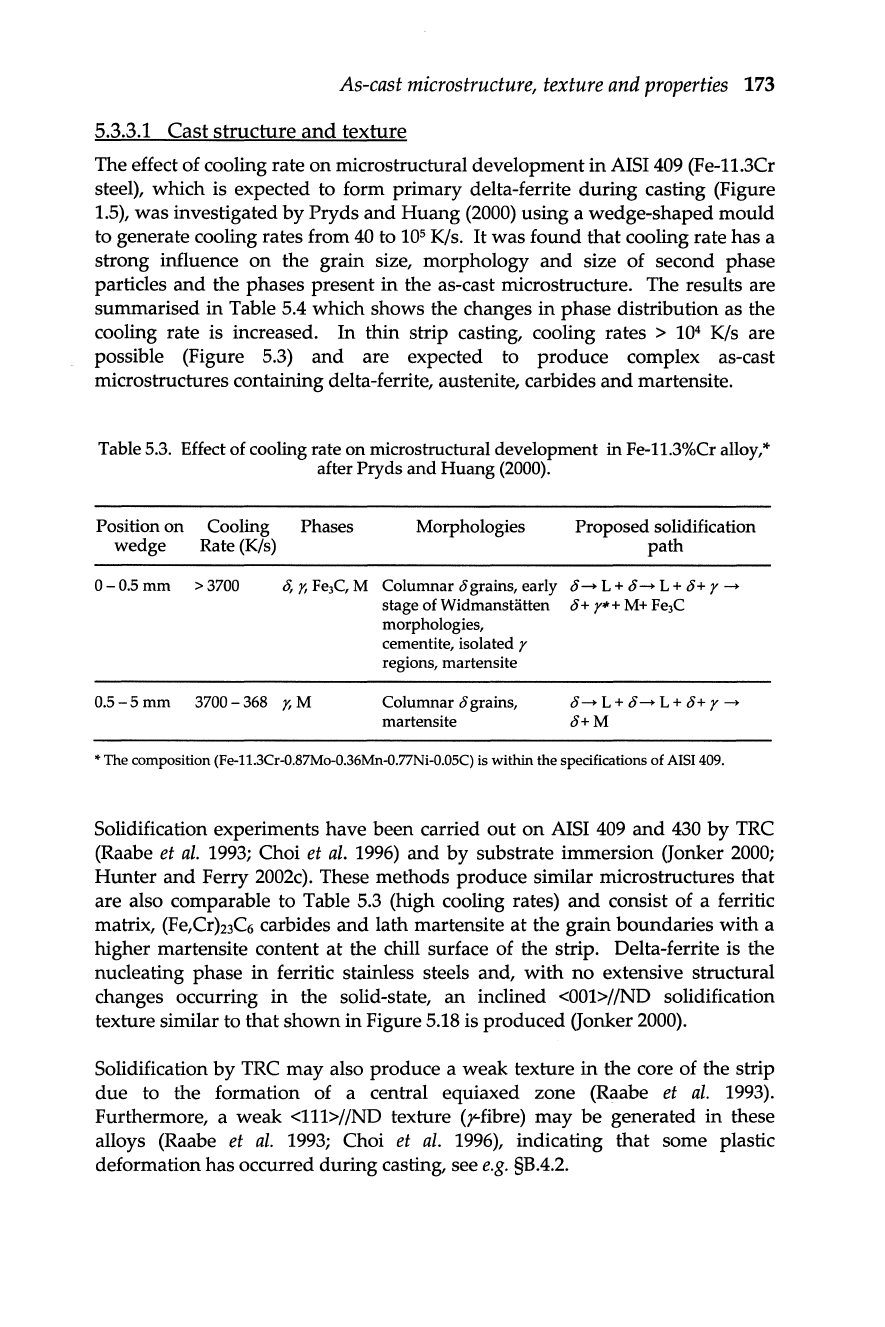
As-cast microstructure, texture
and
properties
173
5.3.3.1
Cast
structure
and
texture
The effect
of
cooling rate
on
microstructural development
in
AISI 409 (Fe-11.3Cr
steel), which is expected to form primary delta-ferrite
during
casting (Figure
1.5),
was
investigated
by
Pryds
and
Huang
(2000)
using a wedge-shaped mould
to generate cooling rates from
40
to
10
5
K/s.
It
was found
that
cooling rate has a
strong influence
on
the grain size, morphology
and
size of second phase
particles
and
the phases present
in
the as-cast microstructure. The results are
summarised
in
Table 5.4 which shows the changes
in
phase
distribution as the
cooling rate is increased. In
thin
strip casting, cooling
rates>
10
4
Kls
are
possible (Figure 5.3)
and
are expected to produce complex as-cast
microstructures containing delta-ferrite, austenite, carbides
and
martensite.
Table
5.3.
Effect
of
cooling rate on microstructural development in Fe-l1.3%Cr alloy, *
after Pryds and Huang
(2000).
Position on
Cooling Phases Morphologies Proposed solidification
wedge
Rate
(K/s)
path
O-O.Smm
>3700
8,
1,
Fe3C,
M
Columnar
8
grains,
early
8-+
L+
8-+
L+
8+
r-+
stage
of
Widmanstatten
8+
r*+
M+
Fe3C
morphologies,
cementite,
isolated
r
regions,
martensite
O.5-Smm
3700-368
1,M
Columnar
8
grains,
8-+
L+
8-+
L+
8+
r-+
martensite
8+M
* The composition (Fe-l1.3Cr-0.87Mo-0.36Mn-O.77Ni-0.05C) is
within
the
specifications
of
AISI 409.
Solidification experiments have been carried
out
on
AISI 409
and
430
by
TRC
(Raabe
et
aI.
1993; Choi
et
al. 1996)
and
by
substrate immersion (Jonker
2000;
Hunter
and
Ferry 2002c). These methods produce similar microstructures
that
are also comparable to Table 5.3 (high cooling rates)
and
consist
of
a ferritic
matrix, (Fe,Crh3C6 carbides
and
lath martensite
at
the grain boundaries
with
a
higher martensite content
at
the chill surface of the strip. Delta-ferrite is the
nucleating phase
in
ferritic stainless steels and,
with
no
extensive structural
changes occurring
in
the solid-state,
an
inclined
<001>/
/ND
solidification
texture similar to
that
shown
in
Figure 5.18 is
produced
(Jonker 2000).
Solidification
by
TRC
may
also produce a
weak
texture
in
the core of the strip
due
to the formation of a central equiaxed zone (Raabe
et
aI.
1993).
Furthermore, a
weak
<111>//ND texture (r-fibre)
may
be
generated
in
these
alloys (Raabe
et
aI.
1993;
Choi
et
al. 1996), indicating
that
some plastic
deformation has occurred
during
casting, see
e.g.
§B.4.2.

174
Direct
strip
casting
of
metals
and
alloys
5.3.3.2 Texture enhancement
during
casting
An
interesting observation was made
by
Hunter
and Ferry (2002b) of the effect
of titanium
on
microstructural development of strip-cast AISI
409
using the
strip casting simulator described in §A.2.2. The titanium level
in
the melt was
either
0.016
or
0.15
wt.% and casting was carried
out
in
air using a smooth
copper
substrate
at a casting speed of
Imls
and
a melt superheat of 75°C.
Figure 5.20 shows
EBSD
micrographs of
both
the solidified surface (CD-TD)
and
ND-TD sections of Ti-free
AISI
409
. There are relatively few nucleation sites
at
the strip surface (Figure 5.20a)
with
coarse columnar grains growing almost
parallel to ND (Figure
5.20b). In contrast, the addition of titanium results in
pronounced grain refinement
at
the strip surface (Figure 5.20c) although the
columnar morphology is retained (Figure
5.20d). The surface grain density
was
- 4 x greater in the Ti-containing steel which indicates the marked effect of
titanium
on
nucleation efficiency.
-NO
(a)
Ti-free steel
(b)
(c)
(d)
Ti-containing steel
Figure 5.20.
EBSD
micrographs of: (a) solidified strip surface
and
(b) ND-TD section of
the Ti-free AISI
409,
and
(c)
solidified strip surface
and
(d) ND-TD section of the Ti-
containing AISI
409
, after
Hunter
and
Ferry (2002b). (Gray grains are those
oriented
with
<001>
within
15
° of ND) (with
kind
permission
of
The Metals, Minerals
and
Materials Society, USA).
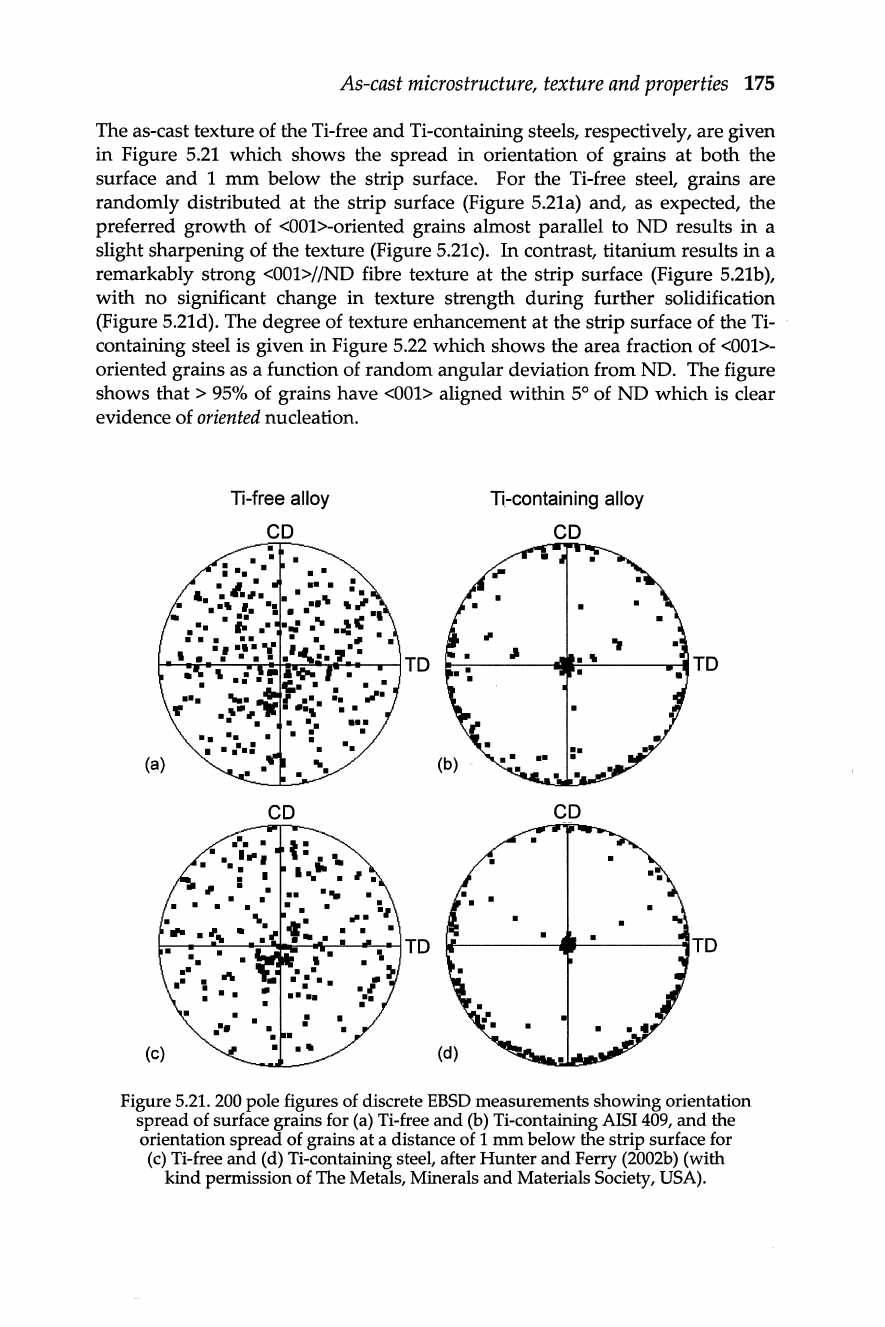
As-cast
microstructure,
texture
and
properties
175
The as-cast texture of the Ti-free
and
Ti-containing steels, respectively, are given
in Figure
5.21
which shows the spread
in
orientation of grains
at
both the
surface
and
1
mm
below the strip surface. For the Ti-free steel, grains are
randomly distributed
at
the strip surface (Figure 5.21a) and, as expected, the
preferred growth of
<OOl>-oriented grains almost parallel to NO results
in
a
slight sharpening of the texture (Figure
5.21c).
In contrast, titanium results
in
a
remarkably strong
<OOl>//NO
fibre texture
at
the strip surface (Figure 5.21b),
with
no
significant change
in
texture strength during further solidification
(Figure 5.21d). The degree of texture enhancement
at
the strip surface of the
Ti-
containing steel is given
in
Figure
5.22
which shows the area fraction of
<001>-
oriented grains as a function of random angular deviation from NO. The figure
shows
that>
95%
of grains have
<001>
aligned within
5°
of NO which is clear
evidence of
oriented
nucleation.
(c)
Ti-free alloy
CD
.-
..
.
....
••
• •
.
CD
•
.
•••
•
• •
• •
. . "
Ti-containing alloy
CD
~------~~----~TD
CD
~------~------~TD
Figure 5.21. 200 pole figures of discrete
EBSD
measurements showing orientation
spread
of surface grains for (a) Ti-free
and
(b) Ti-containing AISI 409,
and
the
orientation spread of grains
at
a distance of 1
mm
below the strip surface for
(c)
Ti-free
and
(d) Ti-containing steel, after
Hunter
and
Ferry (2002b) (with
kind
permission of The Metals, Minerals
and
Materials Society, USA).

176
Direct
strip
casting
of
metals
and
alloys
100
O·············v·
0··············
-
:
....
?ft.
95
....
(
-
(;'
c:
Q)
::s
C"
90
r
~
-
Q)
.=::
?
-
tV
:;
85
....
E
::s
U
80
I I I
0
5
10
15
20
Random
angular
deviation
of
<001>
grains
about
ND
(")
Figure 5.22. Area fraction of <OOl>-oriented surface grains of the as-cast Ti-containing
steel strip as a function of (random) angular deviation from NO, after
Hunter
and
Ferry (2002b) (with
kind
permission of The Metals, Minerals
and
Materials Society, USA).
There are several important factors that,
in
combination, are necessary for
generating this remarkably sharp through-thickness
<001>/
/ND fibre texture
(Hunter and Ferry
2002b).
These include:
(i)
the addition of titanium to the
melt;
(ii) casting
in
a nitrogen-containing atmosphere, and (iii) solidification
onto a smooth substrate; textured (ridged) substrates
do
not
generate the same
effect. The combination of
(i)
and (ii) is expected,
under
certain casting
conditions, to generate Ti-containing particles
(Ozturk
et
al.
1995).
The effect of
(iii) appears to be important for nucleating ferrite grains of a pre-determined
orientation with the smooth substrate surface also ensuring that heat flow is
perpendicular to the substrate surface during solidification (Strezov and
Herbertson
1998).
It
is well-known that Ti-containing compounds have similar
crystallographic features to delta-ferrite and generate the following orientation
relationship (Gregg
and
Bhadeshia
1997):
{OOl}m
/ /
{DOl
}I\-ferrile
<Oll>n-x / /
<OOl>l\-ferrile
Figure
5.23
shows that, for the case of TiN formation, this relationship results
in
a very low planar disregistry (-4%) between the
{DOl}
crystallographic faces of
these particles
and
delta-ferrite which subsequently drastically lowers the
energy barrier for nucleation (see Figure
2.9).
Good lattice matching is a key
requirement for epitaxial growth of ferrite from inclusions of these types (Gregg

As-cast
microstructure,
texture
and
properties
177
and
Bhadeshia 1997; Barbaro
and
Krauklis 1999). The strong through-thickness
<OOl>//NO
fibre texture is therefore probably a result
of
inoculation, whereby
Ti-rich particles
must
either
be
produced directly onto the smooth substrate
(with
{00l}
parallel to the substrate face)
or
form
in
the melt
and
subsequently
contact the substrate
at
the meniscus
during
casting (Hunter
and
Ferry 2002b).
These oriented Ti-rich compounds
at
the substrate/melt interface, together with
the highly directional
heat
flux
during
solidification (using a smooth substrate)
are the key to the nucleation of <OOl>//NO-oriented grains that subsequently
grow to produce the strong through-thickness fibre texture
in
the as-cast strip
(Figure 5.22).
/
/
/
/
,
I
I
I
I
I
I
I
/L
______
_
o-Fe
TiN
Figure
5.23.
Possible crystallographic relationship between
T-N
and delta-ferrite
showing:
(a)
the 45°-rotated cube-to-cube relationship and (b) details
of
lattice registry along coherent TiN/ferrite interface.
5.3.3.3
Comparison
of
texture
development
in
strip-cast
stainless
steels
The transformation sequence
in
austenitic stainless steels
during
solidification is
often more complex than that
in
ferritic stainless steels. Nevertheless,
in
the
absence of inoculation
both
generate
an
almost
random
texture
at
the chill
surface
with
solidification resulting
in
texture strengthening to produce a TO-
rotated
<001>/
/NO
fibre texture. The effect of a
wide
range
of processing
conditions
and
alloy type
on
the development
of
<OOl>//NO
texture
during
solidification is given
in
Figure 5.24. The results
show
a consistent decrease
in
the mean angular deviation of <OOl>-oriented grains from NO,
a<OOl>'
from the
surface to the core of the as-cast strips. This is a clear indication of growth
selection to generate a strong rotated
<OO1>//NO
fibre texture. Figure 5.24
shows that
both
ferritic
and
austenitic stainless steels solidify
in
a similar
manner, despite the difference
in
final crystal structure, the large variation
in
casting conditions
and
the different transformation sequences.

178
Direct
strip
casting
of
metals
and
alloys
40
r---------------------------------~
o
AISI
409
(180
x
20
~m)
(various
superheats)
o
AISI304
(150
x
30
~m)
(various
superheats)
• •
AISI
304
(75
~m)
]
............
<>
AISI304
(150
~m)
Pyramid-shaped
r::
•••
AISI
304
(200
~m)
1
30
\
.•
,
.•
:,'.>
..
D~
..•••......•..•
L... •••••••
..!!!
'.
••••
••.•
0
::J
0>
r::
C\l
20
...............
~
.......................
?
•...•••
0
~
tJ····
..
·
.............
.
····· .. 0 0
r::
C\l
Q)
:2:
10
o
.......•.......
~
...............
:
..
;,
............
..
0.2 0.4 0.6 0.8 1.0
Distance from chill surface (mm)
Figure
5.24. The
development
of
<OO1>//ND
fibre
texture
as
a
function
of
distance from
the
chill surface of a
range
of
as-cast stainless steel
strips
(each
data
point
denotes
the
average
angular
deviation
of <001>
from
ND), after
Hunter
and
Ferry (2002c)
(with
kind
permission
of
Elsevier Limited).
5.3.4
Other
ferrous alloys
Silicon
iron
These alloys contain low carbon
and
high silicon levels to generate single-phase
ferrite
during
solidification (§1.2.3.3). The few published studies
on
OSC of
these alloys have shown that the solidification behaviour is consistent
(Zapuskalov
1996;
Takatani
et
al.
2000;
Park
et
al.
2001;
Landgraf
et
al.
2003).
Takatani
et
al.
(2000)
investigated the solidification
behaviour
of Fe-3%Si alloy
produced
by
TRC using electron backscatter diffraction
(EBSO)
measurements
(§B.2).
It
was
shown
that
nucleation occurs
at
the substrate/melt interface to
produce
an
essentially
random
distribution of grains,
with
the gradual
development of
an
inclined columnar grain structure
in
each shell
of
the strip
(Figure 5.26a). These workers also carried
out
3-0
cellular automata-finite
element (CAFE) modelling (§A.3.3)
and
confirmed
that
liquid metal flowing
relative to the growing dendrites inevitably results
in
their
growth
being
inclined towards the casting direction to generate a symmetrical TO-rotated
<OO1>//NO
fibre texture (Figure 5.26b). The grain structure
and
texture of twin
roll cast silicon iron are therefore similar to
that
produced
in
stainless steel
(§§5.3.2-5.3.3).

As-cast
microstructure,
texture
and
properties
179
CD
CD
1mm
(b
l
__
Figure
5.26.
(a)
Experimental and (b)
CAFE
simulated columnar grain structures
in twin roll cast
Fe-3%Si
alloy.
The
001
pole figures shown in
(a)
are generated
from
EBSD
line scans at % thickness
of
each shell
of
the as-cast strip, after
Takatani
et
al.
(2000)
(with kind permission
of
Elsevier Limited).
Invar
(Fe-NO
alloys
These alloys contain -
35
wt.% Ni and are therefore expected to be austenitic at
room temperature (Figure
1.7). They are usually produced
by
ingot casting
process
but
Park
et
al.
(2002)
have demonstrated that twin roll casting into thin-
gauge sheet is possible and problems of segregation, oxidation
and
cracking
that plague alloys produced
by
conventional processing routes are alleviated.
There are, however, considerable differences
in
the microstructure and texture
as TRC generates a non-uniform structure consisting of a randomly oriented
chill zone
at
the strip surfaces with most of the strip comprising of the classic
columnar microstructure with dendrite deflection angles of
up
to 30°
in
the
casting direction
(Park
et
al.
2002).
Therefore, the TO-rotated
{lOO}<uvw>
texture is again produced throughout much of the strip (see
e.g.
Figure 5.26).
It
has been reported that a weak copper-type rolling texture may develop in the
core of the strip
if
solidification occurs ahead of the roll nip thereby causing a
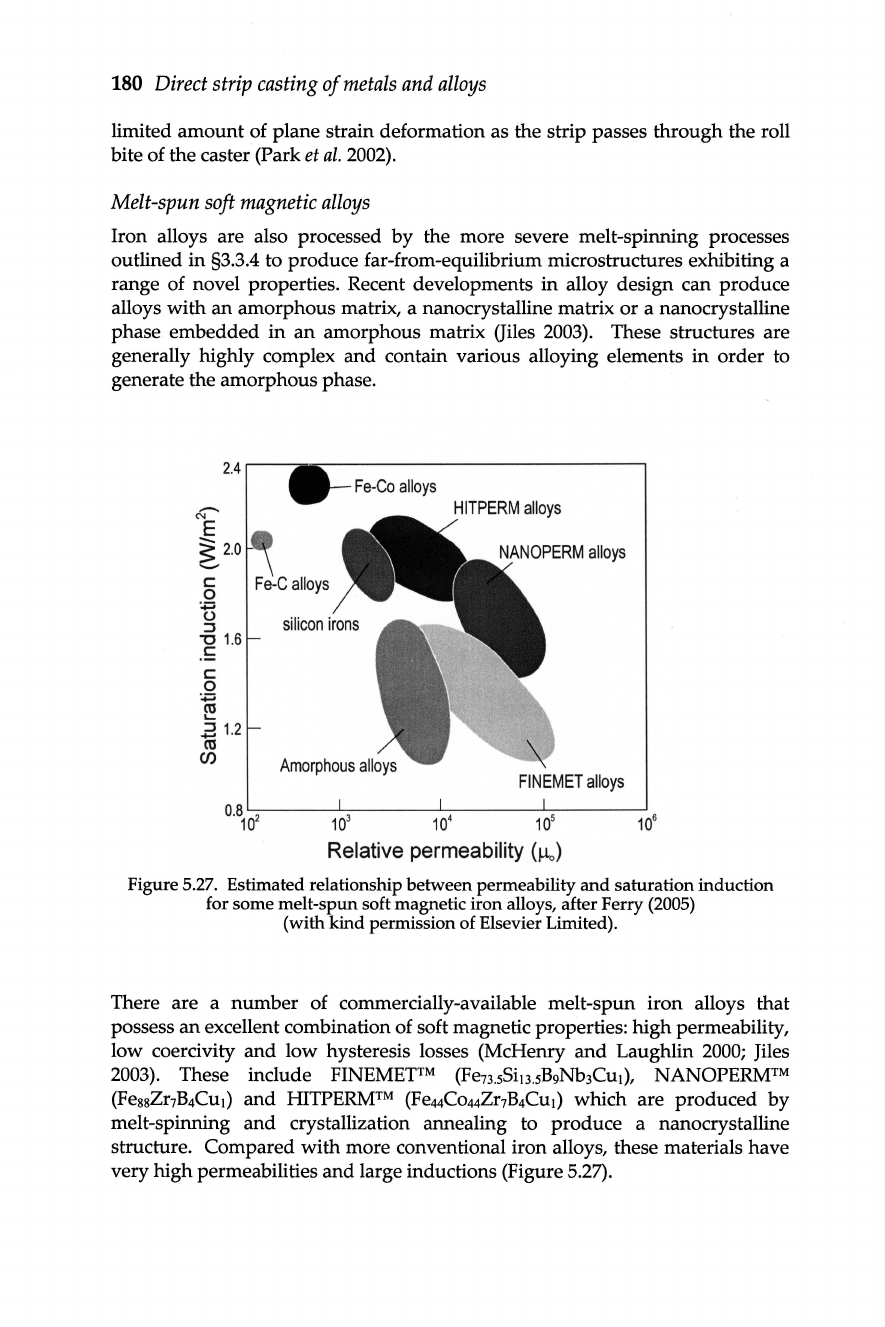
180
Direct
strip
casting
of
metals
and
alloys
limited amount of plane strain deformation as the strip passes through the roll
bite of the caster
(Park
et
ai.
2002).
Melt-spun
soft
magnetic
alloys
Iron alloys are also processed by the more severe melt-spinning processes
outlined in
§3.3.4 to produce far-from-equilibrium microstructures exhibiting a
range of novel properties. Recent developments
in
alloy design can produce
alloys with an amorphous matrix, a nanocrystalline matrix or a nanocrystalline
phase embedded in an amorphous matrix Giles
2003). These structures are
generally highly complex and contain various alloying elements in order to
generate the amorphous phase.
2.4
Fe-Co
alloys
-
HITPERM
alloys
"'
E
~
2.0
'--'
5 a
ll
oys
:0:::;
u
::l
"0
1.6
c:
c:
o
:0:::;
~
21.2
co
Cf)
FINEMET
alloys
0.8 '-:2
,-------'-:
3
------1-,
4-
--
---1
-:
5
-
----'
6
10
10
10
10
10
Relative
permeability
(
J.!o
)
Figure 5.27. Estimated relationship between permeability
and
saturation induction
for some melt-spun soft magnetic iron alloys, after Ferry
(2005)
(with kind permission of Elsevier Limited).
There are a number of commercially-available melt-spun iron alloys that
possess an excellent combination of soft magnetic properties: high permeability,
low coercivity and low hysteresis losses (McHenry
and
Laughlin 2000; Jiles
2003). These include
FINEMETTM
(Fe73.sShsB9Nb3CUl),
NANOPERMTM
(Fe88Zr7B4Cul)
and
HITPERMTM
(Fe44Co44Zr7B4Cul)
which are produced by
melt-spinning and crystallization annealing to produce a nanocrystalline
structure. Compared with more conventional iron alloys, these materials have
very high permeabilities and large inductions (Figure
5.27).
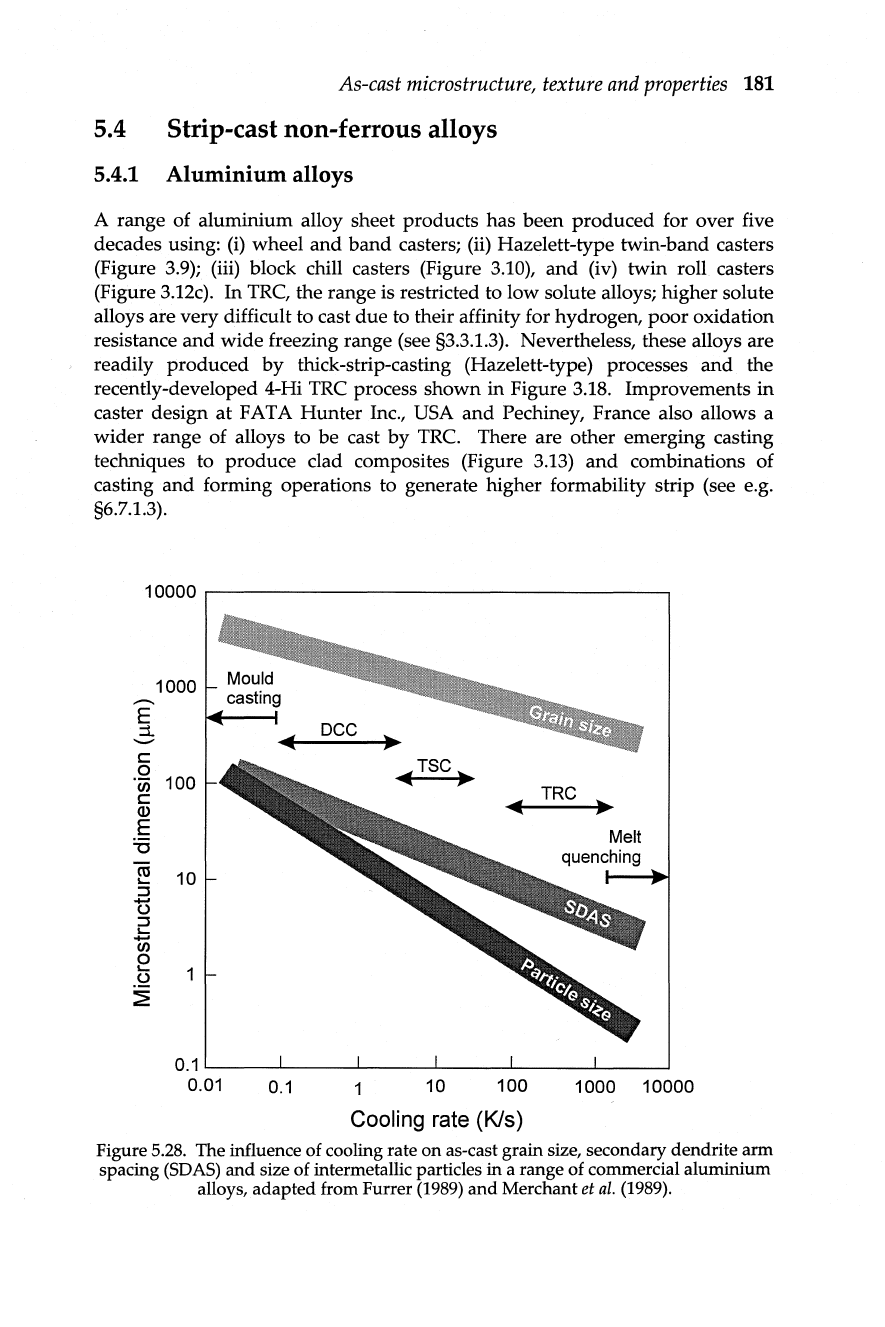
As-cast microstructure, texture
and
properties
181
5.4 Strip-cast non-ferrous alloys
5.4.1
Aluminium
alloys
A range of aluminium alloy sheet products has been
produced
for over five
decades using:
(i)
wheel
and
band
casters; (ii) Hazelett-type twin-band casters
(Figure 3.9); (iii) block chill casters (Figure 3.10),
and
(iv) twin roll casters
(Figure 3.12c). In TRC, the range is restricted to
low
solute alloys; higher solute
alloys are very difficult to cast
due
to their affinity for hydrogen,
poor
oxidation
resistance
and
wide
freezing range (see §3.3.1.3). Nevertheless, these alloys are
readily
produced
by
thick-strip-casting (Hazelett-type) processes
and
the
recently-developed 4-Hi TRC process
shown
in
Figure 3.18. Improvements
in
caster design
at
FAT A
Hunter
Inc., USA
and
Pechiney, France also allows a
wider
range of alloys to be cast
by
TRC. There are other emerging casting
techniques to
produce
clad composites (Figure 3.13)
and
combinations of
casting
and
forming operations to generate higher formability strip (see e.g.
§6.7.1.3).
10000.-----------------------------------~
1000
.-
E
~
•
DCC
•
--
c
•
TSC.
0
·w
100
c
TRC
Q)
• •
E
Melt
~
quenching
Cll
....
10
::J
+-'
()
::J
....
+-'
(J)
0
....
.
~
~
0.1
0.01
0.1
1
10
100
1000
10000
Cooling rate (K/s)
Figure 5.28. The influence of cooling rate
on
as-cast grain size, secondary dendrite
ann
spacing
(SDAS)
and
size of intermetallic particles in a range of commercial aluminium
alloys, adapted from Furrer
(1989)
and
Merchant et
al.
(1989).
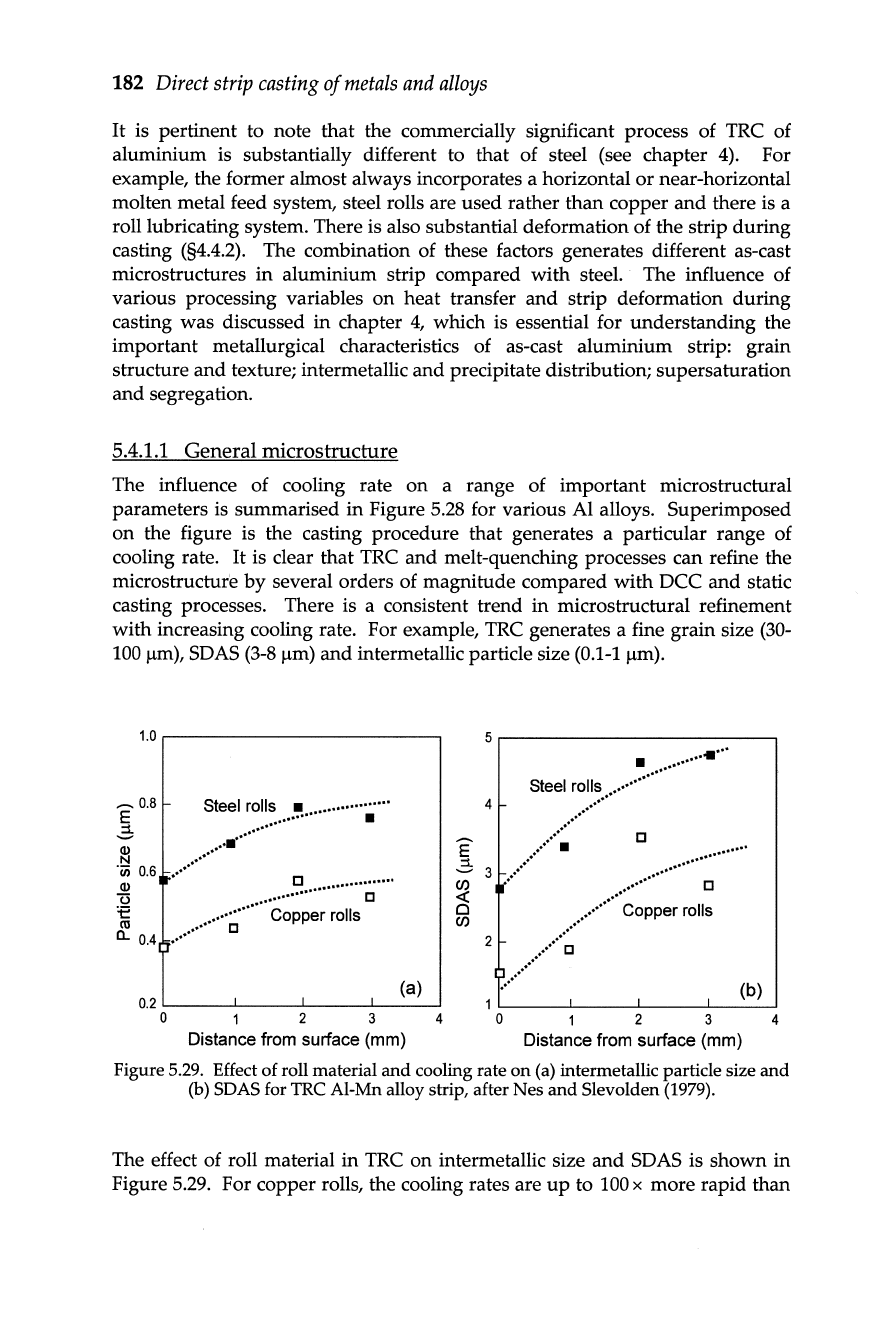
182
Direct
strip
casting
of
metals
and
alloys
It
is pertinent to note that the commercially significant process of
TRC
of
aluminium is substantially different to that of steel (see chapter
4).
For
example, the former almost always incorporates a horizontal or near-horizontal
molten metal feed system, steel rolls are used rather than copper and there is a
roll lubricating system. There is also substantial deformation of the strip during
casting
(§4.4.2).
The combination of these factors generates different as-cast
microstructures
in
aluminium strip compared with steel. The influence of
various processing variables
on
heat transfer
and
strip deformation during
casting was discussed
in
chapter
4,
which is essential for understanding the
important metallurgical characteristics of as-cast aluminium strip: grain
structure and texture; intermetalIic and precipitate distribution; supersaturation
and segregation.
5.4.1.1
General
microstructure
The influence of cooling rate
on
a range of important microstructural
parameters is summarised in Figure
5.28
for various Al alloys. Superimposed
on
the figure is the casting procedure that generates a particular range of
cooling rate.
It
is clear that
TRC
and
melt-quenching processes can refine the
microstructure
by
several orders of magnitude compared with DCC and static
casting processes. There is a consistent trend in microstructural refinement
with increasing cooling rate. For example,
TRC
generates a fine grain size
(30-
100
/lm),
SDAS
(3-8/lm) and intermetalIic particle size (O.l-l/lm).
1.0
r-------------,
.......
E
0.8
Steel rolls - ................ .
.............
-
i
....
··········
'iii
O.S
t
.•
•··
~
••••••
E!
....
••
......
·;;··
..
:e
...........
Copper rolls
III
••
' C
0.
0.4
T
••
••••••
(a)
0.2
l..-
__
-'--
__
"--
__
"--_---'
o
1 2 3
4
Distance from surface (mm)
5r------------.
-
........
.
Steel rolls
•••••••••••
......
.'
......
4
....
. '
.......
.
......
-
-§,
.'
- 3
••••
~
(
en
.'
2
••••••
~
~
......
.
. '
.'
..
'
c
...........................
......
c
••••••••
Copper
rolls
(b)
1L.-
__
"--
__
"--
__
"--_---'
o
1 2 3 4
Distance from surface (mm)
Figure 5.29. Effect
of
roll material
and
cooling rate
on
(a) intermetallic particle size
and
(b) SDAS for TRC AI-Mn alloy strip, after Nes
and
Slevolden (1979).
The effect of roll material
in
TRC
on intermetalIic size and SDAS is shown
in
Figure
5.29.
For copper rolls, the cooling rates are
up
to
100
x more rapid than
